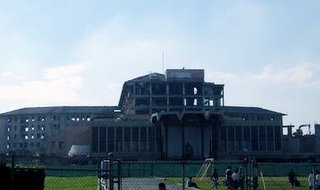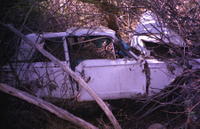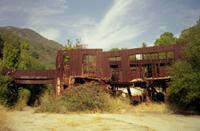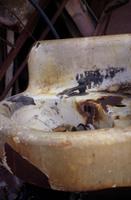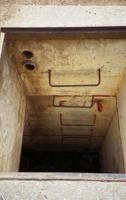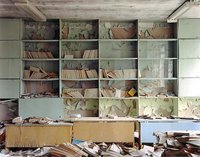

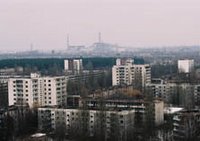
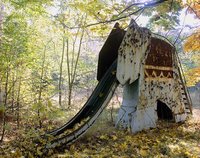
The photos taken above are by Robert Poliodori
Orphaned Structures: Reading Abandoned Buildings Through
an Anthropological Lens
By Jennifer L. Johnson
Jared Diamond opens his latest book Collapse by pointing out that some of the most poignant lessons are drawn from the abandoned ruins of collapsed civilizations. Diamond asserts:
Everyone who has seen the abandoned buildings of the Khmer, the Maya, or the Anasazi is immediately moved to ask the same question: Why did the societies that erected those structures disappear?
As an international bestseller, Diamond’s book indicates popular interest in the topic of abandoned structures as represented in the archaeological record. Yet, if we accept that the archaeological record teaches powerful lessons, why are the abandoned ruins of today, for the most part, absent from anthropology? Like the archaeological remains of the past, the information derived from analysis of present abandoned structures would provide us with models of catastrophe prevention, planning, recovery, and higher environmental standards. The remains of the present give us a chance to examine ourselves in critical ways that collapsed societies did not.
As symbols of something that once lived and breathed, abandoned buildings are mirrors of ourselves as a physical manifestations of our possible future. In this paper, I argue that contemporary abandoned buildings reveal as much about human behavior as the remains of the past societies we study through archaeology. I argue that abandoned buildings and the processes of abandonment should be added as evidence to our body of anthropological research because they represent aspects of modern societies that have failed to coexist sustainably with their environment. Because these places are no longer inhabited, they point to a shift in the structure’s perceived value. For some reason, the abandoned building is no longer useful to the former occupant or a buyer who would be willing to take responsibility for it. Most often, this decline in value is initiated by a depletion of local resources, toxic contamination, or decline in the economy. Nevertheless, these factors (or a combination of factors) render the designer’s once useful investment in technology and manpower obsolete. The boarded up windows and barbed-wire-encircled abandoned buildings are the often the most blatant symptom of an areas decline.
My discussion builds on three notable works that set a new trend in anthropology by investigating the cultural implications of space. The Perfume of Garbage (2004) by David Platt, William Rathje and Michael Shanks, analyze American behavioral patterns implied by the types of garbage we throw away. They remind us that “things that were eminently useful” are now what we most frequently discard. Also, what different people perceive as “garbage” is frequently in dispute. In building on their argument, I argue that tensions arise between those who perceive abandoned buildings as garbage, and those who do not. The Geography of Emptiness by Gary McDonogh (1993) explores the implications of negative spaces (uninhabited places) in the city, by examining the places where people do not go. McDonogh’s theories can be applied to abandoned buildings also. While these studies are instrumental, they do not as I mentioned earlier, examine abandoned buildings as starting points for anthropological analysis.
For the most part, analysis is left to explorers, artists and photographers who are drawn to the structures for out of curiosity. Studies have however, lobbied for anthropological research of our modern inhabited cities. In Imaging and Interpreting the City (1996) Setha Low asks “Why has the city been under-theorized in anthropology?” Low believes “Theorizing the city is a necessary part of understanding the changing postindustrial, advanced capitalist, postmodern moment in which we live. The city as a site of everyday practice provides valuable insights into the linkages of macroprocesses with the texture and fabric of human experience.” If it is agreed that the city is under-theorized, then the abandoned buildings within its borders are under-theorized as well. In extending Low’s argument, I would add that abandoned buildings are symptoms of larger-scale environmental, social and political problems. Within them specifically, they speak of underlying political, social and environmental stresses that may have lead to the buildings decline.
At the least, abandoned buildings serve to corroborate with ethnographic data gathered by anthropologists. Artifacts reveal what people’s memories or motivations fail to. The “Garbage Project” at the University of Arizona (1973), for example, exposed flaws in participant-survey based research (amounts of alcohol intake claimed on surveys contradicted with what the empty containers they tossed into their garbage). Shanks, Rathje & Platt believe historians often “disregard material things altogether.” They add, “the triumph of archaeology is to challenge the “tunnel vision” historians sometimes develop.
Thru a brief case study of the city of Pripyat in the Ukraine, I will focus on photographic evidence with attention to government, class structure, and environment. In drawing a central question from each image, I will then discuss journalistic accounts, ethnographies, sequences of events and ecological data that support the images in revealing underlying tensions between the Soviet government and its citizens.
A Case Study: Pripyat, Ukraine
Pripyat is perhaps the largest abandoned city in the world, located in the center of the 30 kilometer exclusion zone left in the wake of Chernobyl. Pripyat’s history is hinged on the failure of reactor four which exploded at 1:23 am on April 26, 1986, and began one of the worst environmental catastrophes in world history. While the cause is still debated—and varies substantially between sources—most generally blame an experiment conducted on the coolants. The immediate damage was the death of 31 workers, and contamination of 125,000 acres of land for the next 900 years. While the respective governments refuse to acknowledge Chernobyl as a direct link to health problems, The Guardian reported a 2,400 per cent increase in the incident of thyroid cancer, 250 per cent increase in congenital birth deformities, and a 100 per cent increase in cancers such as Leukaemia. The majority of this affected group resided in Pripyat.
Figure 1
Figure 1 is an aerial view of Pripyat in early 1970s. Pripyat was designed as model socialist town, part of the Kievan district of Ukraine. Founded in February of 1970, the city was built for efficiency—to house the workers of Chernobyl and their families who live less than two miles from the reactor. By 1985 the town had already grown to 47,500 citizens, with an expected increase of 2,000 people per year. As evident from figure 1, the city was designed “monocentrically”—that is, the city’s cultural and recreational buildings were built in the center of the city . In contrast to other cities with multiple cultural centers, the planner of Pripyat, Moscow architect Nikolai Ostozhenko, designated only one. Also evident in figure 1 is the communist architecture of the time which demonstrates the communist ideologies of collectivism and a classless society. Each apartment building was built in uniform size and color as one another. The structure of the Soviet political system is evident in the rigidly controlled grid plan. Aspects of the people’s lives are easily controlled when the government designates areas where specific activities should occur. Nature has largely been cleared away from the city, with the exception of the manicured lawns and the trees on the outskirts of the city.
Fig. 2
Fifteen years after the explosion at Chernobyl, the trees evident in figure 2 have replaced the workers of whom the city was designed to house in figure 1. This simple irony alone allows us without any prior knowledge of Chernobyl, the opportunity to question—what happened to the former inhabitants of the city? Is there evidence of tension beyond the explosion that effected Pripyats abandonment? According to The Guardian, when the reactor exploded, it was reported that the citizens of Pripyat watched the flames from their balconies. Immediately after the accident however, elites and daughters of the elites were helicoptered out of the city. Boris Scherbina, Deputy Chairman of the USSR Commission, was the primary organizer of the events after the accident and he was charge of the units of Soviet Chemical Troops. Under his jurisdiction, the citizens of Pripyat, who were the closest city to Chernobyl remained unaware of the accident for 36 hours until the government formally began evacuations. Over 116,000 were citizens evacuated. Yet while elites were being evacuated, Marples reports that “…children attended school, and a wedding and outdoor soccer game were also held in Pripyat.” In fact, not until May 4, were the surrounding villages evacuated, nearly six days after the explosion. The chronology of the evacuation, in contrast with the communist architecture reveals an invisible hierarchy amongst the Soviet people.
Another tension revealed by the abandonment of Pripyat is evident in the planning of the city. Pripyat was a city built for and centered around the production of energy at Chernobyl as an efficient alternative to coal. In the background of figure 2 for example, the towers of the reactors are visible in close proximity to the city. Looking at this image, one is in a similar situation as an early archaeologist at Pompeii who noticed the city stood at the base of a volcano. Unlike Pompeii however, these reactors were man-made and recognized in advance as threat to Pripyat. David R. Marples in a case study of Chernobyl’s effects on the Ukraine and Belarius (1992) cites a KGB report which points to defects in the construction, early leakage into the soil and ill-trained workers. Marples cites an interview with the architect who later expressed sincere regret at building the reactors so close to the city. As precautions are more expensive than investigating safety concerns, the proximity of the reactors in location to the city reflects Soviet priorities of efficiency over safety of its citizens.
Fig. 5
Another tension between the Soviet government and its people can be expressed by the types of people who return to abandoned places. Looters risks their health and the health of others to sell radioactive goods in the black market. An ecologist who resides in the area notes“…a few miles from the site of the explosion we encountered a group of men stealing tiles from the roofs of abandoned houses to sell in Kiev—tiles that are highly contaminated.” Though they are not the original inhabiter, looters likely represent the lowest in the social hierarchy and are so desperate they value contaminated goods left in the wake of the explosion—essentially other people’s garbage—as valuable. McDonogh believes “For others, the emptiness of “no one goes there” represents such a cultural imposition that it eclipses patterns of use therefore marked as deviant and therefore non-existent.” Figure 6 is a room in a public library of Pripyat. The scattered books in the image seen here, are the remains of what looters have already sifted through. One question from looking at figure 5, is, why didn’t looters take the remaining books? A library, an agent of the state decides what the public needs. However, an absence of the law reveals that the public didn’t want what the government gave to them.
Even lower on the social hierarchy, is another group who return to abandoned places. The poorest of poor occupy houses built of flimsy materials that decay far faster than that of government buildings. In her work Life Exposed, Adriana Petrya performed an ethnographical analysis on residents of abandoned villages surrounding Pripyat. One villager asks, ‘does it really matter what we die of—hunger or starvation?” The statement corroborates with Greenbaum’s examination of housing abandonment in black communities. She describes the those who inhabit abandoned places as victims of “ethnographic apartheid.” Places abandoned by their original inhabitant are often are places of violence, drugs are abused, or where squatters and destitute live. In Pripyat, abandoned spaces point not only to a larger trend of discrimination of these villages but exclusion of these elderly from central areas of habitation.
Fig. 5
Further tension is evident by contrasting the stone bust of Lenin (figure 5) to the building materials of poor people’s houses and the following image (images 6). The quickest to decay are often the items built with the cheapest building materials. A hierarchy in a society can also be seen in a hierarchy of decay. Stone signifies a permanence as associated with used to build castles and houses of nobility. Members of high status classes stronger building materials. Ironically, the statue which embodies the abandoned communist ideals of the era will likely outlast the entire city of Pripyat. However, while the government meant for Lenin to be a lasting symbol of the communist legacy, the untended area around the figure suggests the citizens of Pripyat have long abandoned this symbol.
Figure 6.
In contrast to the solid bust of Lenin, is the rusting artificial elephant of figure 6. The elephant, designed as a slide for children, also undergoes a rate of decay faster than the bust of Lenin. Through a citizen of Pripyat’s imagination we see the shape of exotic elephant in a place where it is not native. Within this image is a subtle natural resistance by the Soviet people to conventions of uniformity imposed by the government. Unlike the torso of Lenin, we have an unconventional work by an individuals that does not conform to the uniformity of the government.
While former residents are currently petitioning the UN to make Prypiat a permanent memorial , the government wishes to forget. This is evident in the fact that roads and names of old villages have disappeared from maps. A journalist observes of Belarius “…their names have already disappeared from updated maps Here, abandoned building are forgotten and erased from maps. In doing so, this erases the people who go in them as well. McDonogh sites Wilk and Schiffer (1979) in his explanation of negative space in relation to the government:
Vacant lots occupy a nebulous legal space; as private property, the primary responsibility for protection and enforcement resides with the owner; yet the owner, who does not live there, cannot fully maintain control over use. At the same time, public authorities are unwilling to assume the burden of regulating what is, after all, the use of private property.
The logical reason for the government to do this, is to prevent further looting. If explorers and looters know where to find these places, they would seek them out. But it also suggests the governments denial to acknowledge its former history. In fact, one way to make visible people’s suffering would be to designate Pripyat and its surrounding communities as a memorial. Yet the cost of getting rid of large scale abandoned place like Pripyat is too great a burden for the government and Chernobyl will not be erased from people’s conscious. Sarah Phillips concludes her ethnography in viewing Chernobyl as the catalyst for the fall of the Soviet Union:
It (Chernobyl) became a resource for change. It made the intangible tangible and spurred people and society to action. Chernobyl reminded people in Ukraine that they were not master of their own land, and it underlined the impossibility of trusting the Moscow-centered government to honor their best interests.
As the buildings will be here long after the last victims of Chernobyl pass away, the structures are also powerful symbols for people who were not present. Pripyat examined in actuality does not embody the communist ideals upon which it was built. Underlying the accident is a history of lies told to the Soviet people, and a false trust in the government. While Pripyat’s fall may not have been inevitable for it’s citizens, we as anthropologists can learn from the subtle tensions within these structures. We can learn not to make the same mistakes, or trust those who would make them for us.
The prospects for future studies of abandoned buildings are tremendous. As I mentioned in the introduction, it is not just failures of human-induced environmental catastrophe. In America, the trend of globalization and outsourcing have left vast industrial ruins in places like Flint, Michigan, Chicago and Philadelphia. In El Dorado Texas, technology a 200 million dollar facility is now a habitat for snakes, insects and a common species of bats. Violence and racism in Johannesburg has led to the abandonment of large-scale hotels and office buildings downtown area. In New Orleans the miles of abandoned ruins signal a failure of our technology to overcome nature. The same can be said for the abandoned city of Centralia, Pennsylvania where an underground coal fire started in 1962 will burn for another 50 years. The most tangible lessons to draw from all of these places serve as immediate warnings to connect abstract lessons of the past with the present.
Most importantly, abandonment of our modern places makes clear relationships that otherwise goes unnoticed. If abandoned buildings are signals of our failure to adapt to our environment, then anthropologists must examine these signals more closely. Abandoned buildings, like culture are multi-dimensional. They have life histories that change over time, take on new meanings and are useful in imagining our future because they are past mistakes. And if we are to learn from our past mistakes, abandoned buildings are the best places to start.
Word Count: 2995
Bibliography
Barbalace, Roberta C., (March 29, 2006). Chernobyl Disaster’s Agricultural and Environmental
Impact. Environmental, Chemistry & Hazardous Material News, 1.
Cameron, Catherine M. and Tomka, Steve A., eds. (1993). Abandonment of Settlements
and Regions: Ethnoarchaeological and Archaeolgical Approaches. Cambridge: Cambridge University Press.
Cohen, James, R. (2001) Abandoned Housing: Exploring Lessons from Baltimore. Housing
Policy Debate, vol. 12, 3.
Diamond, Jared. (2005) Collapse: How Societies Choose to Fail or Succeed. New York: Penguin,
7.
Finn, Peter. (2005, October 6). Chernobyl Twenty Years Later. Washington Post, A7.
Graczyk, Michael. (March 26, 2006). $200 Million Dollar Radar Facility Stands Obsolete.
Associated Press, 3.
Greenbaum, Susan. (1993). Housing Abandonment in Inner-City Black Neighborhoods.
In McDonogh, G. & Rotenberg, R. (eds.) The Cultural Meaning of Urban Space. Westport: Bergin & Garvey. (142).
Greenwald, John. (1986, May 26). Gorbachev Goes on the Offensive: Moscow Struggles
to Limit the Damage of the Chernobyl Disaster. Time Magazine, 1.
Kerner, Lucy and Potter, William. (1991). The Soviet Military’s Performance at
Chernobyl. Soviet Studies. Vol. 43. No. 6. 1027-1047.
Leontiev, Yevgeny. (2003). History of Pripyat. Retrieved April 8, 2006, http;://www.prypiat.com.
Low, Setha.“The Anthropology of Cities: Imagining and Theorizing the City,” Annual Review of
Anthropology, 1996, vol. 25, 383-409.
Mayne, Alan and Murray, Tim, eds. (2001). The Archaeology of Urban Landscapes:
Explorations in Slumland. Cambridge: Cambridge University Press.
Marples, David. (1997) The Chernobyl Disaster: Its Effect on Berlarus and Ukraine. Tokyo: United Nations University Press, 53-70/6.
McDonogh, Gary. (1993) The Geography of Emptiness. In McDonogh, G. &
Rotenberg, R. (eds.) The Cultural Meaning of Urban Space. Westport: Bergin & Garvey.
Mycio, Mary. (2005). Wormwood Forest: A Natural History of Chernobyl. Princeton:
The National Academies Press.
Mulvey, Stephen. Chernobyl Diary—Week Two, http://www.news.bbc.uk/chernob7688, BBC,
(accessed April 5, 2006).
Page, Douglas. (1999, November 15). In Hot Pursuit: Research in the Exclusion Zone.
Science Spectra. 15. 34-36.
Petryna, Adriana. (2002). Life Exposed: Biological Citizens after Chernobyl. Princeton:
Princeton University Press.
Pellow, Deborah ed. (1996). Setting Boundaries: The Anthropology of Spatial and Social
Organization. Library of Congress-in-Publication Data.
Phillips, Sarah D. (2004). Chernobyl’s Sixth Sense: The Symbolism of an Ever-Present
Awareness. Anthropology and Humanism, 29, 159-185.
Ponting, Clive. (1991). A Green History of the World: The Environment and the Collapse
of Great Civilizations. New York: Penguin.
Rathje, William. (2003) The Archaeology of Contemporary Landfills. American Antiquity, 57,
No. 3, 437-47.
Rotenberg, Robert. (1993). On the Salubrity of Sites. In McDonogh, G. &
Rotenberg, R. (eds.) The Cultural Meaning of Urban Space. Westport: Bergin & Garvey.
Shanks, Michael, Rathje, William L. & Platt, David. (2004). The Perfume of Garbage:
Modernity and the Archaeological: The World Trade Center and the Paradox of
Garbage. Modernism/Modernity, 11, 61-83.
Suryawanshi, C.C. (1999) Old Dilapidated Buildings: The Mechanism of Collapse, Real
Estate Housing Magazine, pp. 29-41.
Staff Writer. (Dec. 15, 2000). Pripyat: The City Where Times Stands Still. CNN, 4.
Staff Writer, (March 18, 2006). Chernobyl: The Legacy. The Independent, sec. A, 10.
Staff writer, (October 9, 1999). Resetters of Chernobyl. The Guardian, 1.
Staff Writer. (May 10, 2005). South African broadcast corporation. www.sabbc.co.za. //2211.0
Ukrainki, Lesi. (April 2006). Petition to the United Nations and Supreme Council of Ukraine
from the citizens of Pripyat. Kiev, Ukraine: re-printed in Literaturna Ukrainia.
